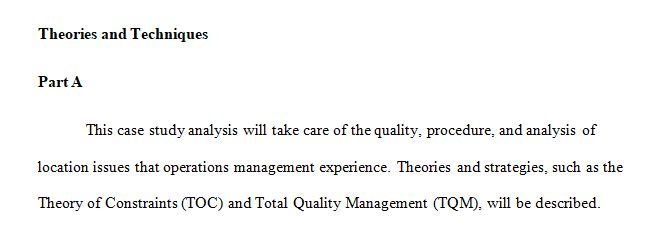Explain the five steps of the theory of constraints (TOC) process.
Explain the five steps of the theory of constraints (TOC) process. To what processes might the company in the case study apply TOC? Why would applying TOC to these processes be advantageous?
For the Theory of Constraints you can list the steps as described on page 316 of our OM textbook.
You may find it helpful to list out as follows:
Step 1-Identify the constraint. During this step, BYD would…
Step 2-Develop a plan for overcoming the identified constraint, BYD would…
Step 3-Etc…
Be sure to provide an in-text citation for page 316 of our OM textbook. Please be sure to provide your own thoughts to what processes BYD might apply the Theory of Constraints. Also, state the benefits (advantages) of TOC here as well. As you address this section, you may find page 26 of the BYD case study helpful.
- Describe how total quality management (TQM) principles and tools can be used to improve quality in the latest line of products in the context of the case study.
For this critical element, write out a few sentences regarding what TQM is, and then 1-2 paragraphs on how these tools can be applied to improve quality at BYD. TQM is described on pages 217-229 of our OM textbook. Basically, how can benchmarking, continuous improvement, employee empowerment, Six Sigma, etc. and TQM tools assist BYD in producing quality products?
Data Analysis
- Draw a cause-and-effect diagram that assesses why some of the company’s supply chain partners might have struggled to implement some of the company’s newly developed materials. Summarize your findings from the diagram.
The cause-and-effect diagram should be specific to supply chain partners failing to implement new materials for BYD. This is a what-if (hypothetical) scenario and you can brainstorm different reasons why a supply chain partner may fail to implement new materials. Your diagram (at minimum) needs to include issues with manpower, method, inventory, and equipment. You should have at least three specific causes for each major cause category. Page 226 of our OM textbook provides an example of a cause-and-effect diagram.
You will also need to write a paragraph summarizing your cause-and-effect diagram. For example, BYD supply chain partners might struggle to implement new materials because of…
You may consider using the below template (please ensure you enable macros). The Problem Statement and Major Cause Categories have already been filled in for you.
Note: You will have to cut-and-paste the actual fishbone diagram into your word document or create one. If you choose to upload as an attachment, please be sure to indicate this within your word doc. Do not copy and paste a completed fishbone from another source; I need to see your work.
- Draw a hypothetical process (time-function) map for producing a recently released (within the past two years) product manufactured by the company. As an operations manager, how will you use the value map? Be sure to include your process map within your case study analysis.
Page 289 provides an excellent example of a time function process map.
The first column going down describes your different areas doing the work:
Sales
Production Input
Assembly Plant
Warehouse
Finish Plant
Transport (Final Product)
Note: Please indicate the number of days it takes for the product to get through each “area”. Also, include the total amount of time on the horizontal axis it will likely take to complete the entire project ex. 50 days. The days are basically “made-up” by you and how long you think each process at BYD might take. Steps that align vertically to other steps means they happen at the same time.
After creating the time function map (either on your own or using a template), provide a few sentences explaining how you, in an OM capacity, would use the map. Many students note excess hold (wait) times when building the time function map so they can easily identify and “call-out” inefficiencies.
- Considering the data and options below, determine where the company should locate its new manufacturing plant. Explain why this would be the favorable location.
You will use the data provided in the rubric to apply the factor rating method to determine the most favorable location for BYD’s new plant – Mexico City or Columbia, SC. Please ensure you include the chart with the calculated totals in your submission. Please see pages 345 & 346 of our OM textbook. The most favorable location will be the one with the highest overall weighted score. Please be sure to also explain why this (either Mexico City or Columbia, SC) is the “best” location (specific factors) and include additional factors of consideration.
Answer preview Explain the five steps of the theory of constraints (TOC) process.
APA
1201 words

